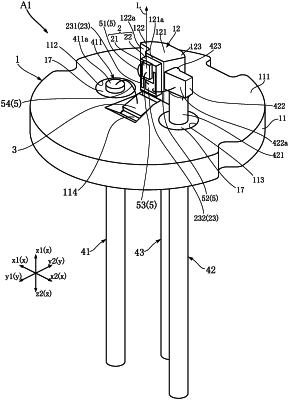| CPC H01S 5/02345 (2021.01) [H01S 5/022 (2013.01); H01S 5/023 (2021.01); H01S 5/02212 (2013.01)] | 12 Claims |

|
1. A semiconductor laser device comprising:
a semiconductor laser chip that emits laser light in an emitting direction;
a base having a plate-like shape; and
a block protruding from the base in the emitting direction and supporting the semiconductor laser chip,
wherein the block has a supporting surface and a first wire bonding surface, the supporting surface facing a first side in a first direction perpendicular to the emitting direction and supporting the semiconductor laser chip, the first wire bonding surface being a surface to which a first wire electrically connected to the semiconductor laser chip is connected,
the first wire bonding surface is shifted in a second direction, which is perpendicular to the emitting direction and the first direction, with respect to the supporting surface, and
the first wire bonding surface is inclined relative to the supporting surface, such that the first wire bonding surface is more offset from the supporting surface to a second side in the first direction with increasing distance from the supporting surface in the second direction,
the semiconductor laser device further comprises a first lead and a second lead that are supported by the base,
the first lead and the second lead flank the supporting surface, and are separated apart from each other in the second direction,
the first lead has a first protruding portion that protrudes from the base in the emitting direction, and the second lead has a second protruding portion that protrudes from the base in the emitting direction,
the second protruding portion has a protruding length greater than that of the first protruding portion,
the second protruding portion has an end portion separated apart from the base in the emitting direction and formed with a second wire bonding surface for connecting a second wire electrically connected to the semiconductor laser chip, and
the second wire bonding surface is inclined relative to the supporting surface, such that the second wire bonding surface is more offset to the second side in the first direction with increasing distance from the supporting surface in the second direction.
|